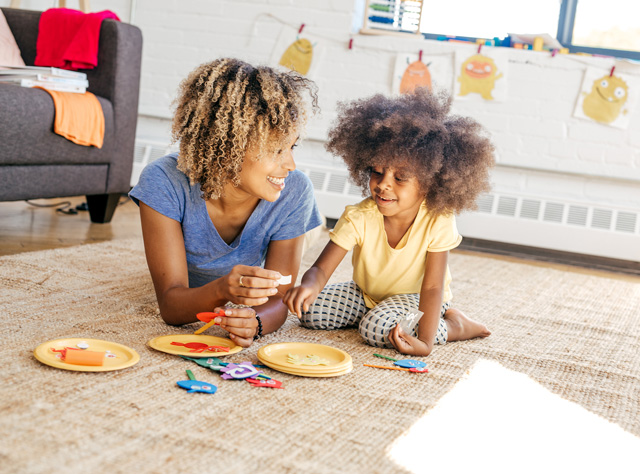Young children love to play. Child-led and open-ended play helps young children develop and learn. Child-led means that the child chooses the activity or the topic and is the leader of the play. Leading play comes naturally to a young child. In this blog, we will describe some strategies for expanding a child’s play in three common play scenarios.
Hello? Play with Phones
Think of all the times your child starts playing with an imaginary “phone” and has a conversation. Join in that play! Get on the “other line” and talk over the telephone. Your child might say “hello.” You could say, “Hi, Joanie! How are you today?” This builds on their language and follows their interest in phones. You could make your child a toy phone from a piece of cardboard or let them play with an old phone.
By pretending play with phones, your child is imitating your grown-up use of the phone. Through this play, children also get more comfortable using the phone to communicate in real life. You can involve your child in conversations with your phone. For example, put your phone on speaker and have your child respond to a family member. Use video calls to have your child connect with other family and friends through action and speaking.
Roar! Dinosaurs
Another popular interest with young children is dinosaurs. If your child shows you a dinosaur toy, join in and say, “Wow, you are showing me your dinosaur. Should we make the dinosaur dance or roar?” Then you can build on their interest in dinosaurs by finding books on dinosaurs from your local library and reading them together.
Another way to build on their interest is to draw or color in dinosaurs with paper and crayons, which helps build your child’s fine motor control. Using blocks or other found materials such as cardboard from your recycling bin, you and your child can build a dinosaur home or habitat.
Do What I Do! Dolls and Stuffed Animals
You child may show an interest in dolls or stuffed animals, carrying one with them as they play. You could help the child learn more about routines in the house using the doll or animal as a model of the behavior you want to see in your child. “Look, this is how the teddy bear brushes his teeth. Can you do it too?” You could also build on your child’s play by following their lead exploring social-emotional issues. “I hear you say your baby doll is crying. What can we do to make her feel better?”
You could incorporate additional content such as clothing and weather. “I see that you are getting your dinosaur dressed. What’s the weather like today? What kind of clothes should we find for him?” There are many ways to extend play with dolls and stuffed animals.
Summary
Child-led play is fun and helps your child learn and grow in their imagination, communication, and motor skills. Join in the fun with your child today!

Natalie Danner
Dr. Natalie Danner is a Content Specialist for the Illinois Early Learning Project. She has worked in university-based early childhood teacher preparation programs in Nebraska, Oregon, and Connecticut and as an early childhood teacher and school leader in New York City and Arizona. She earned her Ph.D. in early childhood special education from the University of Illinois at Urbana-Champaign.
Biography current as of 2021


